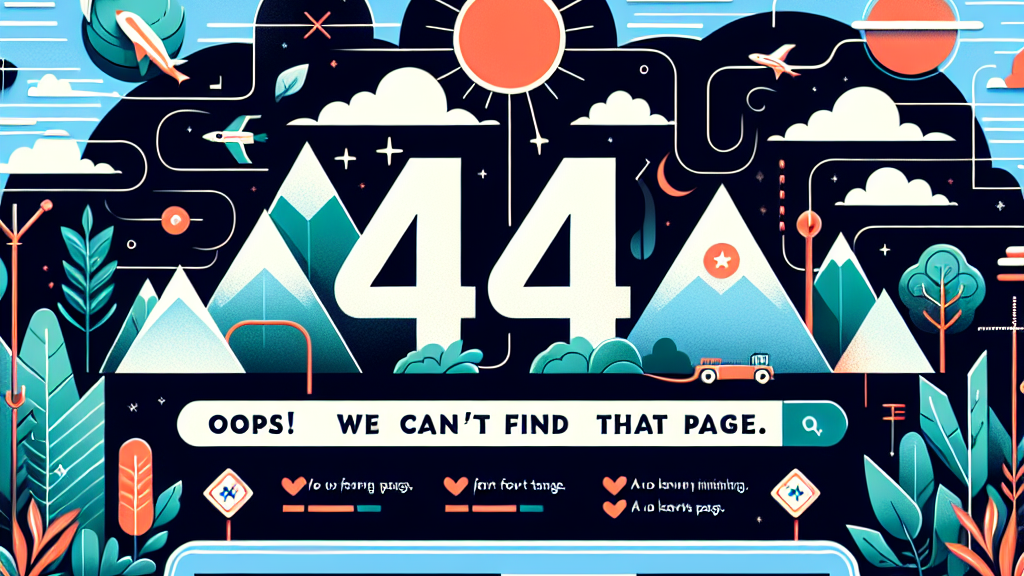Transforming 404 Error Pages: Converting Setbacks into Opportunities
Encountering a 404 error page while browsing the web can be frustrating, like hitting a dead end or getting lost in a maze. However, these error pages can be turned into an opportunity to captivate users and enhance their website experience. By following best practices and drawing inspiration from successful examples, you can turn a setback into a chance to impress and retain your audience.
Visual Appeal: Making It Look Good
When designing a 404 error page, prioritize visual appeal. Engaging visuals can help soften the frustration of encountering an error. Consider using eye-catching graphics, illustrations, or animations to captivate users and make the error page more memorable. By turning a negative experience into a visually pleasing one, you can leave a positive impression.
Real-Life Examples: A Creative Journey
To understand the power of a well-crafted 404 error page, let’s look at some real-life examples. A recent study analyzed over 50 brands to identify best practices in creating 404 pages. These examples showed different approaches, from formal to lighthearted and humorous. Each brand tailored its error page to match its brand identity and tone, emphasizing design consistency. Drawing inspiration from these examples can help you find a unique approach that resonates with your audience.
Error Messaging: Showing the Way
While aesthetics are important, the primary goal of a 404 page is to guide users back on track. Clear error messaging is crucial for users to understand why they encountered the error and what steps to take next. Whether suggesting alternative URLs, providing navigation options, or offering a search function, the goal is to help users find what they were looking for. By providing clear guidance, you can minimize frustration and keep users engaged.
Support and Assistance: Reaching Out for Help
In addition to clear error messaging, include contact information or a link to a support/help center on the 404 page. This allows users to easily seek assistance if needed, reducing frustration and enhancing the user experience. By showing willingness to help, you can build trust and a stronger relationship with your audience. Remember, a little support can turn a frustrating encounter into a positive experience.
Behind the Scenes: Understanding the 404 Error
To grasp the significance of a 404 error page, it’s important to understand its underlying cause. A 404 error page appears when a user tries to access a URL that no longer exists. This can happen due to broken links or deleted/moved content. The 404 status code signals to users and search engines that the webpage cannot be found on the web server. By addressing these underlying issues and providing a helpful error page, you can improve the overall user experience on your website.
Learning from Mistakes: The Importance of Quality
Unfortunately, not all 404 pages are created equal. Some examples show poorly designed error pages that lack clarity and guidance, leaving users feeling even more lost. These examples remind us of the importance of investing time and effort into creating a useful and user-friendly 404 error page. By avoiding common mistakes and focusing on quality, you can ensure that your error page serves its purpose effectively.
E-commerce Excellence: Turning Setbacks into Success
In e-commerce, 404 pages are crucial for retaining customers. By incorporating search functionality, category navigation, cart preservation, and customer reviews, e-commerce websites can turn a potentially negative experience into an opportunity to showcase their products and services. These examples demonstrate the power of thoughtful design and functionality in capturing and retaining customers. Don’t underestimate the potential of a well-crafted 404 page to make a lasting impression.
SaaS Solutions: A Seamless Experience
SaaS companies also understand the importance of well-crafted 404 pages. With a clean and minimalistic design, these error pages provide a seamless and consistent user experience. By offering search functionality and guiding users back to relevant sections of the website, SaaS companies can ensure that users stay engaged and find what they need. Remember, even in the world of software, a well-designed 404 page can make a difference.
In conclusion, the design and functionality of a 404 error page can significantly impact the user experience on your website. By incorporating engaging visuals, clear error messaging, and helpful functionality, you can turn a frustrating encounter into an opportunity to impress and retain your audience. Drawing inspiration from best practices and real-life examples across various industries can guide you in creating a 404 page that not only solves the problem but also leaves a positive impression on your users. So, let’s turn those dead ends into engaging experiences!











